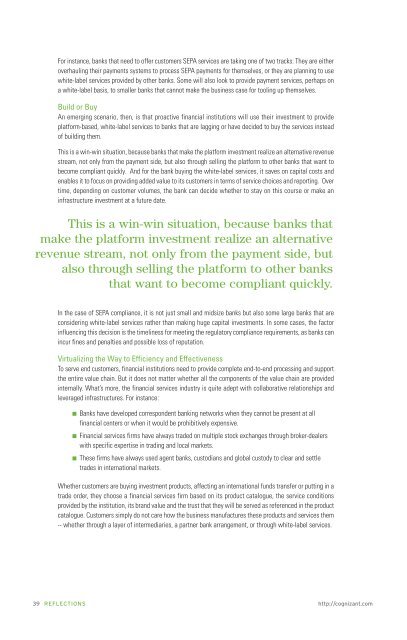Reflections - Cognizant
Reflections - Cognizant
Reflections - Cognizant
- No tags were found...
Create successful ePaper yourself
Turn your PDF publications into a flip-book with our unique Google optimized e-Paper software.
For instance, banks that need to offer customers SEPA services are taking one of two tracks: They are eitheroverhauling their payments systems to process SEPA payments for themselves, or they are planning to usewhite-label services provided by other banks. Some will also look to provide payment services, perhaps ona white-label basis, to smaller banks that cannot make the business case for tooling up themselves.Build or BuyAn emerging scenario, then, is that proactive financial institutions will use their investment to provideplatform-based, white-label services to banks that are lagging or have decided to buy the services insteadof building them.This is a win-win situation, because banks that make the platform investment realize an alternative revenuestream, not only from the payment side, but also through selling the platform to other banks that want tobecome compliant quickly. And for the bank buying the white-label services, it saves on capital costs andenables it to focus on providing added value to its customers in terms of service choices and reporting. Overtime, depending on customer volumes, the bank can decide whether to stay on this course or make aninfrastructure investment at a future date.This is a win-win situation, because banks thatmake the platform investment realize an alternativerevenue stream, not only from the payment side, butalso through selling the platform to other banksthat want to become compliant quickly.In the case of SEPA compliance, it is not just small and midsize banks but also some large banks that areconsidering white-label services rather than making huge capital investments. In some cases, the factorinfluencing this decision is the timeliness for meeting the regulatory compliance requirements, as banks canincur fines and penalties and possible loss of reputation.Virtualizing the Way to Efficiency and EffectivenessTo serve end customers, financial institutions need to provide complete end-to-end processing and supportthe entire value chain. But it does not matter whether all the components of the value chain are providedinternally. What’s more, the financial services industry is quite adept with collaborative relationships andleveraged infrastructures. For instance:■ Banks have developed correspondent banking networks when they cannot be present at allfinancial centers or when it would be prohibitively expensive.■ Financial services firms have always traded on multiple stock exchanges through broker-dealerswith specific expertise in trading and local markets.■ These firms have always used agent banks, custodians and global custody to clear and settletrades in international markets.Whether customers are buying investment products, affecting an international funds transfer or putting in atrade order, they choose a financial services firm based on its product catalogue, the service conditionsprovided by the institution, its brand value and the trust that they will be served as referenced in the productcatalogue. Customers simply do not care how the business manufactures these products and services them-- whether through a layer of intermediaries, a partner bank arrangement, or through white-label services.39 REFLECTIONS http://cognizant.com
















